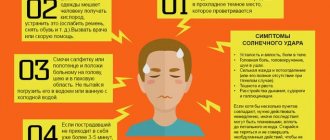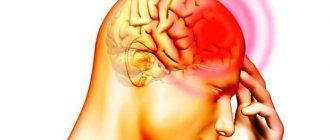Causes of fainting and its warning signs
Fainting occurs as a result of decreased blood flow and, consequently, lack of oxygen in the brain. A sudden narrowing of blood vessels, a drop in blood pressure due to a sudden change in posture, disruption of the heart - all these factors disrupt cerebral circulation, causing blackout. This short-term loss of senses, lasting from a few seconds to two minutes, is medically called syncope or fainting.
Despite the rapid development of this condition, it is possible to notice the characteristic signs of impending loss of consciousness. There is a feeling of weakness in the legs or general lightheadedness, dizziness, flickering before the eyes and ringing in the ears, the skin turns pale and becomes covered in cold sweat.
A person instinctively tries to lie down or sit down with his head hanging between his legs, which helps prevent falling and even loss of consciousness itself. For some time after recovering from a fainting state, a rare and weak pulse, low blood pressure, pallor and general weakness persist.
Symptoms of fainting
A pre-fainting state is characterized by symptoms such as dizziness, severe weakness, nausea, icy sweat (usually felt in the back), tinnitus, blurred vision (up to the appearance of so-called “white noise” in front of the eyes), severe paleness and grayness of the skin.
Already in a faint, a person usually falls, the pupils stop responding to light sources, the pulse worsens or disappears altogether, and breathing becomes weak.
After fainting, the victim is still very weak and is not advised to try to get up for some time. This may cause another attack.
So, common signs of fainting are weakness and falling. If someone around you has fallen, and the symptoms of this situation resemble a short-term loss of consciousness, you need not to get lost, but immediately begin to act.
General classification of fainting
It is not always possible to find out why a person faints. Transient spasm of cerebral vessels also occurs in healthy young people who do not have heart problems. It can be caused by one or several factors: sudden external influences (pain, fear), an accidental malfunction of an organ or a serious illness, and even acceleration due to going up in an elevator.
Depending on the cause, the following types of fainting are distinguished:
- Neurogenic - occurs due to disruption of the autonomic nervous system.
- Somatogenic - their occurrence is caused by changes in the body due to diseases or disruptions in the functioning of internal organs. Among them, the most common are loss of consciousness of a cardiogenic nature, occurring due to diseases of the cardiovascular system.
- Psychogenic - caused by nervous shock, accompanying anxiety or hysteria.
- Extreme - provoked by extreme environmental factors: poisoning, lack of oxygen in the air, changes in atmospheric pressure when climbing mountains, etc.
Fainting (Loss of consciousness)
Home page / Directory of diseases
December 30, 2020
Loss of consciousness is a symptom of many diseases. Sometimes it is a consequence of an acute transient lack of blood circulation in the brain and then we are talking about “syncope”, and sometimes it is a sign of much more serious events in the body. Regardless of the reasons, any loss of consciousness frightens others who, panicking, begin to make mistakes when providing first aid. How will be correct? To do this, it is worth understanding why loss of consciousness occurs.
Symptoms of loss of consciousness Fainting and loss of consciousness - what is the difference? There is no difference, since fainting is a loss of consciousness for a short time (usually up to 1 minute). The main precursor can be called a pre-fainting state. And speaking about the symptoms of loss of consciousness, most often they mean the symptoms of a pre-fainting state: - a feeling of lightheadedness, nausea creeps up; - the heart begins to beat quickly; - circles and spots appear before the eyes; - vision loses clarity; - a strong knock appears in the temples; - cold sweat is released profusely; - there is a feeling of imminent fall.
It is at this moment that emergency measures must be taken to prevent loss of consciousness. Timely provision of first aid is also extremely important. However, fainting can occur quite suddenly, without this “warning”. Its symptoms cannot go unnoticed by others: - a person suddenly loses his balance and falls “in a sheaf”; - loss of consciousness occurs; - the skin becomes pale; - Limbs may twitch and urine may leak involuntarily.
Having regained consciousness, the person feels overwhelmed and experiences severe drowsiness. Causes of fainting
There are many reasons why people faint, and almost all of them are associated with a sharp decrease in the intensity of blood flow in the brain. Among the most common causes of loss of consciousness are disorders of the nervous system (50% of all cases) and heart pathologies (25%). Also, immediately before unconsciousness, the following may occur: - vascular function may be impaired due to a pre-stroke condition, atherosclerosis; - increased pressure in the vessels of the skull due to hydrocephalus, tumor, hemorrhage; - the amount of sugar and oxygen in the body decreases, which occurs with kidney pathologies, hypoglycemia, anemia; - decreased circulating blood volume due to bleeding.
Causes of frequent fainting
The causes of frequent fainting are classified into a separate group. They are usually associated with various mental disorders that manifest themselves periodically, for example, hysterical neurosis. A sudden disruption in blood flow can occur with epilepsy. Often first aid for fainting is necessary for people with low blood pressure and diabetes. A drop in vascular tone can cause fatigue, neurosis, and even a simple transition from a sitting state to a standing state and vice versa.
There are also specific causes in women and men that lead to short-term loss of consciousness. Causes of fainting in men
1. Alcohol poisoning. 2. Tight collar of a business suit. 3. Excessively intense physical training. 4. Night urination in older men.
Causes of fainting in women
1. Internal bleeding due to gynecological diseases. 2. Various pregnancy disorders. 3. Diet is too strict. 4. An overly powerful surge of emotions.
First aid for fainting
If a person faints, there is a high probability of serious bruise or even injury. If you yourself feel faint, you need to take a safe position if possible, it is best to lie down with your head lower.
What to do if a person faints in your presence? Try to catch it in time - this will protect you from possible injuries.
Providing first aid for fainting: - position the patient in such a way as to improve blood supply to the head - raise your legs and try to lower your head slightly lower than your body; - loosen the patient’s collar, open the window in the room for air access; - Sprinkle water on your face, apply ammonia to your nostrils; - the patient has come to his senses - offer him something sweet; - if possible, give an intravenous injection of glucose - this will improve blood circulation.
If help for loss of consciousness is provided in a timely manner, the person will feel better within a few minutes. Types of fainting
In medicine, there are three main types of fainting.
1. With neurogenic, there is a temporary disorder of cardiovascular reflexes that control the dynamics of blood in the body. This type is diverse: - vasodepressor - consequences of excessively strong emotions, stress, fear, they occur most often; - orthostatic are caused by a sharp transfer of the body from a lying position to an upright one; — fainting due to tight collars is explained by too high sensitivity of the carotid sinus; - loss of consciousness in older men when urinating at night, coughing, defecating - a consequence of a sharp increase in intrathoracic pressure.
2. If a patient has disturbances in heart rhythm, problems with the conduction of cardiac tissue are observed, and myocardial infarction is diagnosed, then they speak of cardiogenic loss of consciousness.
3. If, due to sudden fear, panic, or anxiety, a person’s breathing unconsciously becomes faster and deeper, causing loss of consciousness, such fainting is classified as hyperventilation.
In addition, there are classifications that distinguish:
- maladaptive form - when fainting is caused by adaptation to external conditions (a person overheats, etc.); - anemic - when the volume of hemoglobin and red blood cells drops sharply, and the remaining is not enough to fully supply the brain with oxygen; - hypoglycemic - when the level of glucose in the body drops; - extreme forms - when the body gets into extreme conditions: high mountain air, burns, intoxication with harmful substances, drugs.
Diseases that cause fainting
Patients with arrhythmia may experience fainting because the blood supply to the brain is sharply reduced. With bradycardia, symptoms of loss of consciousness are also observed. The reasons are a sharp, almost instantaneous drop in heart rate to 30 or even 20 beats per second when the norm is 65-72.
In addition, patients with fainting may need help with: - pulmonary hypertension; - dehydration; - Parkinson's disease; - with aortic stenosis; - diabetes mellitus.
Which doctor will help?
First aid for loss of consciousness can be provided by an ambulance team, especially if an injury occurred due to a fall. If such conditions recur, you should contact a cardiologist. Depending on the diagnostic results, the patient may also be referred to a neurologist or gastroenterologist. Diagnostics
1. The initial examination consists of listening to the patient’s complaints about the frequency and duration of fainting states, and determining the conditions under which loss of consciousness occurs. A neurological examination is performed.
2. The patient must be sent for laboratory blood tests.
3. Among instrumental studies, the most effective are: - various types of ECG; - echocardiography; — computer sphygmomanometry; — cardiac rhythmography; - 24-hour blood pressure monitoring; — duplex scanning of blood vessels.
These are the most modern diagnostic methods that identify the objective cause of fainting and allow you to prescribe optimal treatment. Prevention
Knowing what to do if you faint, you must also take care of preventive measures: - eat rationally (it is better to consult your doctor about your individual diet); - moderate physical activity must be present; - walk at least 2 hours a day; — women during pregnancy should regularly visit a gynecologist; — eliminate extreme loads and overheating; - among medications, the doctor can prescribe nootropics (Phenotropil, Mexidol, Mexiprim, Omaron, Nootropil, etc.), venotonics (Detralex, Venarus, etc.), adaptogens (Cardioace, Cogitum, Enerion, etc.), vitamins (Vitrum, Complivit, etc. etc.).
Even if you have experienced a fainting state once, this is already a reason to see a doctor. And repeated fainting is a mandatory reason to visit a cardiologist and conduct professional diagnostics.
Neurogenic syncope
The majority of all cases of loss of consciousness occur due to an imbalance in the peripheral nervous system. which leads to a sharp decrease in blood pressure, causing an autonomic reflex reaction. Such fainting occurs even in children during the growth period. The cause may be either vasodilation (in this case we speak of vasomotor syncope) or a decrease in pulse rate (vasovagal syncope). The reasons that cause them are different, but usually obvious.
- Strong emotions (pain, fear, nervous shock, the sight of blood), prolonged standing, heat or stuffiness provoke vasopressor fainting. They develop gradually and can be prevented by noticing the signs mentioned above.
- When a person stands up suddenly, especially after sleeping or sitting for a long time, there is a risk of orthostatic syncope. It also occurs due to hypovolemia (as a result of blood loss, diarrhea, vomiting, etc.), after prolonged bed rest, as a result of taking medications that lower blood pressure. But sometimes its cause lies in autonomic failure or polyneuropathy.
- A tight collar, tie or neckerchief that is too tight when turning your head pinches the arteries that carry blood to the brain. Carotid sinus syndrome (sinocarotid syncope) is observed. Similar irritation of the peripheral nerves leads to loss of consciousness when swallowing.
- Nighttime urination after sleeping in a warm bed can cause a rare occurrence of nocturic syncope in men (mainly older people).
Actions to take if you faint:
- Do not run to the side or make way if a passerby begins to fall. You need to support him with your hands and carefully lay him on his back, protecting him as much as possible from injury.
- If vomiting occurs, turn your head to the side and open the victim’s mouth.
- Provide access to fresh air. Unbutton your clothes if they are constricting your chest or neck: tight collar, tie, bra.
- Raise your legs: place a bag, a stone, a pillow.
- Feel the pulse and listen to breathing. Once you are sure of their presence, you can try to revive the victim by splashing his face with cold water. If you have ammonia, wet a handkerchief with it and bring it to the victim’s nose.
- If there is no breathing or pulse, begin cardiopulmonary resuscitation and call an ambulance.
Heart disease and other somatic causes of loss of consciousness
Of all the fainting spells of a somatic nature, the leading one is cardiogenic. It occurs when a person has diseases of the cardiovascular system. Loss of consciousness in this case occurs suddenly, without pain or other previous symptoms, as a result of a decrease in cerebral blood flow due to a sharp decrease in cardiac output.
The reasons lie in diseases such as:
- arrhythmias;
- vegetative-vascular dystonia;
- cardiac ischemia;
- pulmonary embolism;
- other vascular lesions that prevent blood flow to the heart.
Chronic respiratory diseases (pneumonia, bronchial asthma, emphysema) contribute to bettolepsy - loss of consciousness during a severe coughing attack. Changes in blood composition due to anemia, hypoglycemia, renal or liver failure increase the risk of oxygen starvation of the brain and sudden fainting.
First aid rules for fainting - what to do if you faint, and what not to do?
First aid for a person who faints is as follows:
- We eliminate (if any) the factor causing fainting. That is, we take (take) a person out of a crowd, a cramped room, a stuffy room (or we bring him into a cool room from the street), we take him out of the road, we take him out of the water, etc.
- We provide the person with a horizontal, stable position - the head is lower than the body, the legs are higher (for blood flow to the head, if there is no head injury).
- We lay him on his side to prevent the tongue from retracting (and to prevent the person from choking on vomit). If it is not possible to lay the person down, we sit him down and lower his head between his knees.
- Next, you should irritate the skin receptors - spray the person’s face with cold water, rub the ears, pat the cheeks, wipe the face with a cold wet towel, provide air flow (unfasten the collar, belt, corset, open the window), allow ammonia (vinegar) to inhale - 1 -2 cm from the nose, slightly moistening the cotton wool.
- Wrap yourself in a warm blanket when your body temperature is low.
When a person comes to his senses:
- You can't eat or drink right away.
- You cannot immediately take a vertical position (only after 10-30 minutes).
- If a person does not come to his senses:
- We urgently call an ambulance.
- We check the free flow of air into the respiratory tract, pulse, and listen to breathing.
- If there is no pulse or breathing, we perform indirect cardiac massage and artificial respiration (“mouth to mouth”).
If an elderly person or a child faints, if there is a history of serious illnesses, if the fainting is accompanied by convulsions, loss of breathing, if the fainting happens out of the blue for no apparent reason, suddenly, call an ambulance immediately. Even if a person quickly regains consciousness, there is a risk of a concussion and other injuries.
Treatment of fainting
In case of loss of consciousness, therapeutic measures are related to the cause that provoked it. It is for this reason that adequate diagnosis is so important.
Emergency care for fainting, first of all, involves restoring hemodynamics by placing the torso in a horizontal position. In this case, the foot end must be raised.
Some types of fainting conditions do not require specific treatment, for example, extreme fainting (it is necessary to eliminate only the situation that caused the condition).
Somatogenic syncope involves treating the underlying illness. So, for example, when cardiac arrhythmia is detected, it is necessary to use antiarrhythmic drugs to normalize the rhythm.
In the treatment of loss of consciousness caused by neurogenic factors, pharmacopoeial drugs and non-pharmacological measures (physical measures) are used. In this case, preference is given to the latter. Patients are taught to avoid situations that can provoke neurogenic syncope, as well as to take timely measures to prevent loss of consciousness when they feel the warning signs of syncope.
Physical measures include the following actions. When fainting approaches, patients are advised to cross their lower limbs and clench their palms into fists. The essence of the described actions is to provoke an increase in blood pressure sufficient to prevent loss of consciousness or delay it in order to enable the patient to assume a safe horizontal position. Individuals suffering from persistent orthostatic fainting benefit from regular orthostatic training.
Therapy for reflex fainting should be aimed at improving physical condition, reducing human excitability, correcting autonomic dysfunctions and vascular disorders. It is important to adhere to the regime and perform daily hygienic gymnastic exercises in the morning.
Fainting woman
Gentle ladies and young ladies of past centuries considered it good form to escape from all everyday difficulties and delicate situations with the help of a banal fainting spell. This passage was facilitated by tight corsets, squeezing the ribs and making breathing difficult, dietary restrictions leading to anemia, and a mobile psyche, loosened by reading French novels.
Today, women most often faint while in full health due to menstrual bleeding. This happens for the following reasons:
- neglecting to take iron-containing drugs on critical days, which prevent the development of acute posthemorrhagic anemia against the background of heavy menstruation,
- the presence of untreated gynecological or hormonal problems leading to disruption of uterine contractility and provoking menstrual pain, easily relieved with indomethacin.
Fainting in pregnant women
A pregnant woman should not normally faint. Although in an interesting situation, multiple prerequisites are created for the deterioration of cerebral blood flow. The uterus, stretched by the fetus, puts intense pressure not only on the internal organs, provoking venous stagnation, but also on the inferior vena cava, impairing venous return to the heart and somewhat reducing the portions of blood pushed out by the heart to the brain. Therefore, with a grown belly it is not recommended:
- independently lean forward and down
- wear tight clothes or underwear
- squeezing the neck with collars or scarves
- sleep on your back.
Immediately after childbirth, compression causes of fainting disappear.
https://www.youtube.com/watch?v=ytdevru
The second most common cause of fainting in pregnant women is anemia (see pregnancy and low hemoglobin). During gestation, iron is excessively spent on the growth of the unborn baby and depletes the mother's blood of the main oxygen carrier - hemoglobin. After labor hemorrhage, anemia can not only persist, but also increase.











